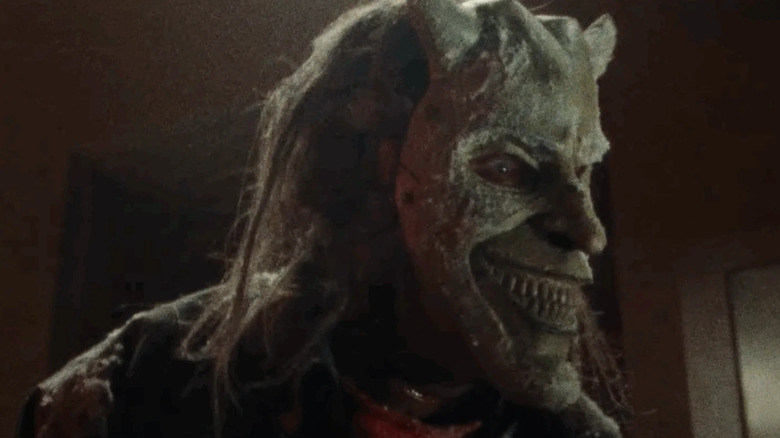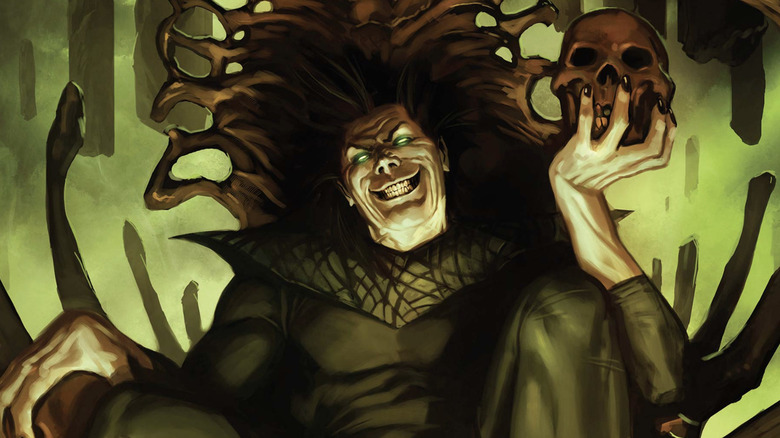How Black Phone 2 Realizes Director Scott Derrickson's Unused Doctor Strange Plans
"Dead is just a word," says the evil Grabber (Ethan Hawke) in "Black Phone 2," who has returned from beyond the grave to menace his attempted victim turned slayer, Finney (Mason Thames). Bringing the Grabber back as a ghost was the logical way forward for a "Black Phone" sequel. The first film was about the ghosts of the Grabber's past victims helping Finney overcome their killer, so now the sequel flips that with a malevolent ghost. The Grabber targets Finney's psychic sister, Gwen (Madeleine McGraw), in revenge. He can only get to her while she dreams, but the harm he causes there reverberates back on the physical world.
The Grabber's return has gotten "Black Phone 2" many comparisons to the slasher franchise "A Nightmare on Elm Street." The Grabber is now basically Freddy Krueger (Robert Englund), an undead child murderer, back to kill again by invading victims' nightmares. While the Freddy influence is undeniable, the premise of a dream killer made me think of a different kind of Nightmare. "Black Phone" director Scott Derrickson directed the 2016 Marvel Studios film "Doctor Strange," telling how surgeon Stephen Strange (Benedict Cumberbatch) became a sorcerer. Derrickson was initially set to direct a "Doctor Strange" sequel, but he left in 2020 over creative differences.
2022's "Doctor Strange in the Multiverse of Madness" was directed by Sam Raimi, instead, and starred Strange fighting a corrupted Wanda Maximoff/Scarlet Witch (Elizabeth Olsen). Derrickson, though, was saying as far back as the original "Doctor Strange" press tour that his sequel villain pick was Nightmare, the lord of the "Dream Dimension." With "Black Phone 2" and the ghostly Grabber, he's told a story about a villain who comes for you in your nightmares ... and maybe gotten his interest in such a villain out of his system.
In Black Phone 2, the Grabber feels like Marvel's Nightmare
Nightmare was the very first Doctor Strange villain. He appeared in 1963's "Strange Tales" #110, by Stan Lee and Steve Ditko, the debut appearance of Doctor Strange. Despite that title, Doctor Strange was originally only a back-up star in "Strange Tales." The main character of the book (who got cover space and longer stories) was the Human Torch from "Fantastic Four." The first Doctor Strange and Nightmare story runs a scant five pages. A man who is haunted by terrible nightmares comes to Strange for help, so Strange astral projects into the Dream Dimension and faces Nightmare.
In his debut, Nightmare is depicted as a cloaked shadow riding a dark horse. That soon evolved into his more famous design: a gaunt humanoid with deathly pale skin, pointed ears like an elf, wild black hair, fangs, and a green body-suit costume. Nightmare rather resembles a vampire, but one savors the fear and negative emotions of humans' dreams instead of blood.
Nightmare swiftly returned in later "Strange Tales" stories, with plans ranging from abducting humans' astral selves in their sleep to simple revenge on Strange. To this day, he remains one of Strange's preeminent enemies, alongside evil sorcerer Baron Karl Mordo and the Dread Dormammu. His schtick of "evil demon haunting dreams" makes him a flexible villain, one who has also fought Spider-Man, the X-Men, and more.
He still hasn't made it to the MCU, though. (Nightmare did show up as a villain in the cartoon "Ultimate Spider-Man," voiced by Mark Hamill.) For a glimpse at the kind of villain Nightmare could've been in Derrickson's unmade "Doctor Strange 2," "Black Phone 2" is as good as it gets.
"Black Phone 2" is currently playing in theaters.

